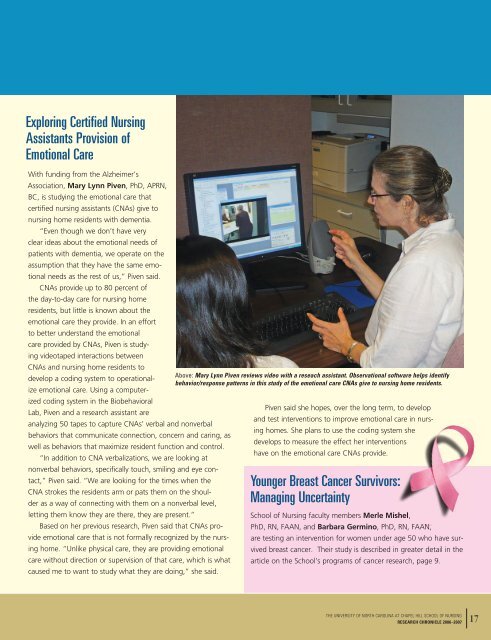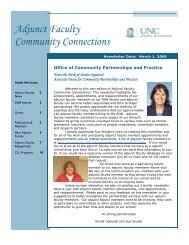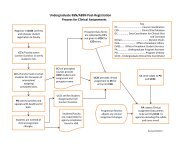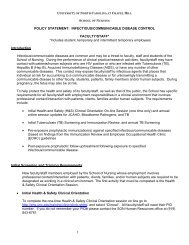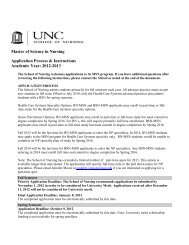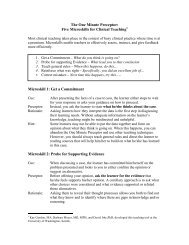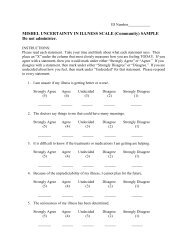Research Chronicle, 2006 - School of Nursing - University of North ...
Research Chronicle, 2006 - School of Nursing - University of North ...
Research Chronicle, 2006 - School of Nursing - University of North ...
Create successful ePaper yourself
Turn your PDF publications into a flip-book with our unique Google optimized e-Paper software.
Exploring Certified <strong>Nursing</strong><br />
Assistants Provision <strong>of</strong><br />
Emotional Care<br />
With funding from the Alzheimer’s<br />
Association, Mary Lynn Piven, PhD, APRN,<br />
BC, is studying the emotional care that<br />
certified nursing assistants (CNAs) give to<br />
nursing home residents with dementia.<br />
“Even though we don’t have very<br />
clear ideas about the emotional needs <strong>of</strong><br />
patients with dementia, we operate on the<br />
assumption that they have the same emotional<br />
needs as the rest <strong>of</strong> us,” Piven said.<br />
CNAs provide up to 80 percent <strong>of</strong><br />
the day-to-day care for nursing home<br />
residents, but little is known about the<br />
emotional care they provide. In an effort<br />
to better understand the emotional<br />
care provided by CNAs, Piven is studying<br />
videotaped interactions between<br />
CNAs and nursing home residents to<br />
Above: Mary Lynn Piven reviews video with a reseach assistant. Observational s<strong>of</strong>tware helps identify<br />
develop a coding system to operational-<br />
behavior/response patterns in this study <strong>of</strong> the emotional care CNAs give to nursing home residents.<br />
ize emotional care. Using a computerized<br />
coding system in the Biobehavioral<br />
Piven said she hopes, over the long term, to develop<br />
Lab, Piven and a research assistant are<br />
and test interventions to improve emotional care e in nurs-<br />
analyzing 50 tapes to capture CNAs’ verbal and nonverbal<br />
ing homes. She plans to use the coding system she<br />
behaviors that communicate connection, concern and caring, as<br />
develops to measure the effect her interventions ns<br />
well as behaviors that maximize resident function and control.<br />
have on the emotional care CNAs provide.<br />
“In addition to CNA verbalizations, we are looking at<br />
nonverbal behaviors, specifically touch, smiling and eye contact,”<br />
Piven said. “We are looking for the times when the Younger Breast Cancer Survivors:<br />
CNA strokes the residents arm or pats them on the shoulder<br />
as a way <strong>of</strong> connecting with them on a nonverbal level, Managing Uncertainty<br />
letting them know they are there, they are present.”<br />
<strong>School</strong> <strong>of</strong> <strong>Nursing</strong> faculty members Merle Mishel,<br />
Based on her previous research, Piven said that CNAs pro- PhD, RN, FAAN, and Barbara Germino, PhD, RN, FAAN, AAN<br />
vide emotional care that is not formally recognized by the nurs- are testing an intervention for women under age 50 who have suring<br />
home. “Unlike physical care, they are providing emotional vived breast cancer. Their study is described in greater detail in the<br />
care without direction or supervision <strong>of</strong> that care, which is what article on the <strong>School</strong>’s programs <strong>of</strong> cancer research, page 9.<br />
caused me to want to study what they are doing,” she said.<br />
THE UNIVERSITY OF NORTH CAROLINA AT CHAPEL HILL SCHOOL OF NURSING<br />
RESEARCH CHRONICLE <strong>2006</strong>–2007<br />
17


